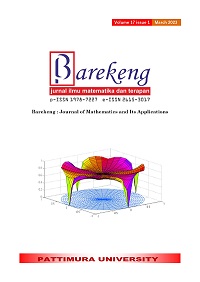ANALYSIS OF THE MAGNETOHYDRODYNAMICS NANOVISCOUS FLUID BASED ON VOLUME FRACTION AND THERMOPHYSICAL PROPERTIES
Abstract
Fluid flow control is applied in engineering and industry using computational fluid dynamics. Based on density, fluids are divided into two parts, namely non-viscous fluids and viscous fluids. Nanofluid is a fluid that has non-viscous and viscous characteristics. Nanoviscos fluid flow is interesting to study by considering the effect of volume fraction and thermophysical properties. Nanoviscous fluid flow models form dimensional equations that are then simplified into dimensionless equations. Dimensionless equations are converted into non-similar equations using flow functions and non-similar variables. Nanoviscous fluids with Cu particles and water-based fluids have higher temperatures and faster velocity. Based on the effect of volume fraction, the velocity of the nanoviscous fluid moves slower, while the temperature of the nanoviscous fluid increases.
Downloads
References
A. S. Jenifer, P. Saikrishnan, and R. W. Lewis, “Unsteady MHD Mixed Convection Flow of Water over a Sphere with Mass Transfer,” J. Appl. Comput. Mech., vol. 7, no. 2, pp. 935–943, 2021, doi: 10.22055/jacm.2021.35920.2761.
B. Widodo, Mathematical Modeling. ITSpress, 2012.
S. Choi, “Nanofluid technology: current status and future research.,” Energy, p. 26, 1998, [Online]. Available: http://www.ncbi.nlm.nih.gov/pubmed/11048%5Cnhttp://www.osti.gov/energycitations/product.biblio.jsp?osti_id=11048
A. Khan, M. Ashraf, A. M. Rashad, and H. A. Nabwey, “Impact of heat generation on magneto-nanofluid free convection flow about sphere in the plume region,” Mathematics, vol. 8, no. 11. pp. 1–18, 2020. doi: 10.3390/math8112010.
B. Widodo, C. Widodo, B., Anggriani, I., Imron, D. Aryany, N. Asiyah, F. A. Widjajati, and K. Kamiran, “The effect of magnetohydrodynamic nano fluid flow through porous cylinder,” AIP Conf. Proc., vol. 1867, no. August, 2017, doi: 10.1063/1.4994472.
O. Mahian et al., “Recent advances in modeling and simulation of nanofluid flows-Part I: Fundamentals and theory,” Phys. Rep., vol. 790, pp. 1–48, 2019, doi: 10.1016/j.physrep.2018.11.004.
Y. Norasia and Z. Zulaikha, “Pengaruh Partikel Nano Zn dan ZnO terhadap Aliran MHD Fluida Nano Pada Lapisan Batas Bola Bermagnet,” Sq. J. Math. Math. Educ., vol. 1, no. 2, p. 133, 2019, doi: 10.21580/square.2019.1.2.4792.
T. Gul et al., “Magneto hydrodynamic and dissipated nanofluid flow over an unsteady turning disk,” Adv. Mech. Eng., vol. 13, no. 7, pp. 1–11, 2021, doi: 10.1177/16878140211034392.
Y. Norasia, B. Widodo, and D. Adzkiya, “Pergerakan Aliran MHD Ag-AIR Melewati Bola Pejal,” Limits J. Math. Its Appl., vol. 18, no. 1, p. 15, 2021, doi: 10.12962/limits.v18i1.7888.
H. Wei et al., “Effect of volume fraction and size of Al2O3nanoparticles in thermal, frictional and economic performance of circumferential corrugated helical tube,” Case Stud. Therm. Eng., vol. 25, no. February, p. 100948, 2021, doi: 10.1016/j.csite.2021.100948.
M. Z. Abdullah, K. H. Yu, H. Y. Loh, R. Kamarudin, P. Gunnasegaran, and A. Alkhwaji, “Influence of Nanoparticles on Thermophysical Properties of Hybrid Nanofluids of Different Volume Fractions,” Nanomaterials, vol. 12, no. 15, p. 2570, 2022, doi: 10.3390/nano12152570.
Adnan, U. Khan, N. Ahmed, S. T. Mohyud-Din, M. D. Alsulami, and I. Khan, “A novel analysis of heat transfer in the nanofluid composed by nanodimaond and silver nanomaterials: numerical investigation,” Sci. Rep., vol. 12, no. 1, pp. 1–11, 2022, doi: 10.1038/s41598-021-04658-x.
Y. Norasia et al., “Laminar Viscous Fluid Flow with Micro-rotation Capabilities through Cylindrical Surface,” vol. 6, no. 4, pp. 865–875, 2022.
B. Widodo, D. K. Arif, D. Aryany, N. Asiyah, F. A. Widjajati, and K. Kamiran, “The effect of magnetohydrodynamic nano fluid flow through porous cylinder,” AIP Conf. Proc., vol. 1867, no. August 2017, 2017, doi: 10.1063/1.4994472.
S. Mojumder, S. Saha, S. Saha, and M. A. H. Mamun, “Combined effect of Reynolds and Grashof numbers on mixed convection in a lid-driven T-shaped cavity filled with water-Al2O3 nanofluid,” J. Hydrodyn., vol. 27, no. 5, pp. 782–794, 2015, doi: 10.1016/S1001-6058(15)60540-6.
C. Renon, M. Fénot, M. Girault, S. Guilain, and B. Assaad, “An experimental study of local heat transfer using high Prandtl number liquid jets,” Int. J. Heat Mass Transf., vol. 180, p. 121727, 2021, doi: 10.1016/j.ijheatmasstransfer.2021.121727.
R. A. Arul Raja, J. Sunil, and R. Maheswaran, “Estimation of Thermo-Physical Properties of Nanofluids using Theoretical Correlations,” Int. J. Appl. Eng. Res., vol. 13, no. 10, pp. 7950–7953, 2018, [Online]. Available: http://www.ripublication.com
C. J. Etwire, I. Y. Seini, R. Musah, and O. D. Makinde, “Combined Effects of Variable Viscosity and Thermal Conductivity on Dissipative Flow of Oil-Based Nanofluid over a Permeable Vertical Surface,” Diffus. Found., vol. 16, no. June, pp. 158–176, 2018, doi: 10.4028/www.scientific.net/df.16.158.
M. N. Bello et al., “Reaction Dynamics of Rocket Propellant with Magnesium Oxide Nanoparticles,” Energy and Fuels, vol. 29, no. 9, pp. 6111–6117, 2015, doi: 10.1021/acs.energyfuels.5b00905.
K. A. Mohammed, A. R. A. Talib, N. A. Aziz, and K. A. Ahmed, “Three dimensional numerical investigations on the heat transfer enhancement in a triangular facing step channels using nanofluid,” IOP Conf. Ser. Mater. Sci. Eng., vol. 152, no. 1, 2016, doi: 10.1088/1757-899X/152/1/012057.
Copyright (c) 2023 Yolanda Norasia, Mohamad Tafrikan, Bhamakerti Hafiz Kamaluddin

This work is licensed under a Creative Commons Attribution-ShareAlike 4.0 International License.
Authors who publish with this Journal agree to the following terms:
- Author retain copyright and grant the journal right of first publication with the work simultaneously licensed under a creative commons attribution license that allow others to share the work within an acknowledgement of the work’s authorship and initial publication of this journal.
- Authors are able to enter into separate, additional contractual arrangement for the non-exclusive distribution of the journal’s published version of the work (e.g. acknowledgement of its initial publication in this journal).
- Authors are permitted and encouraged to post their work online (e.g. in institutional repositories or on their websites) prior to and during the submission process, as it can lead to productive exchanges, as well as earlier and greater citation of published works.






1.gif)



